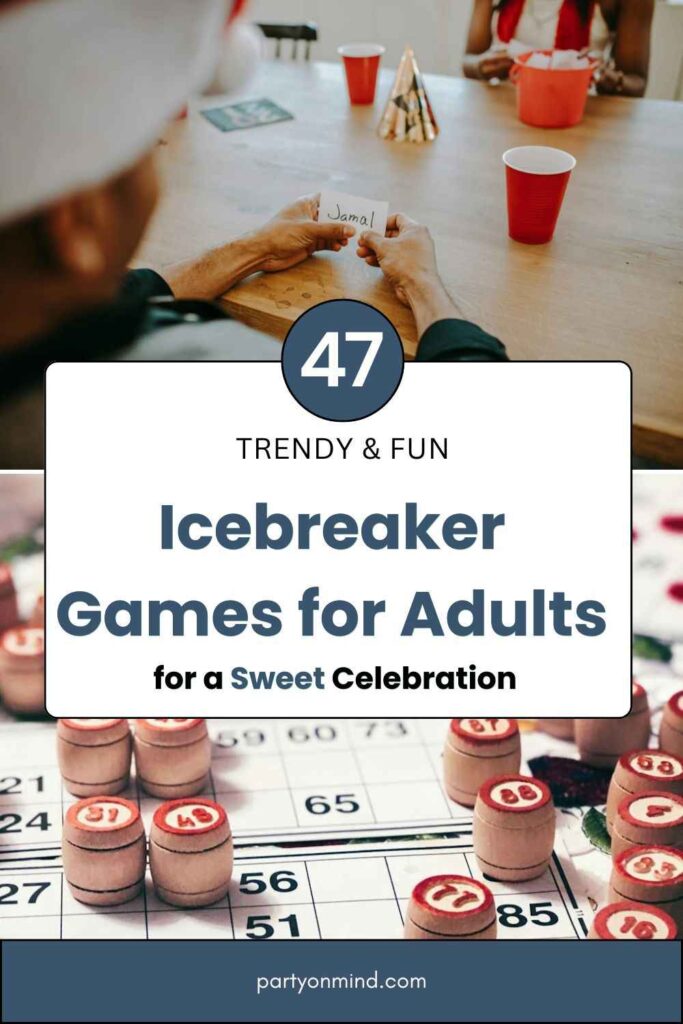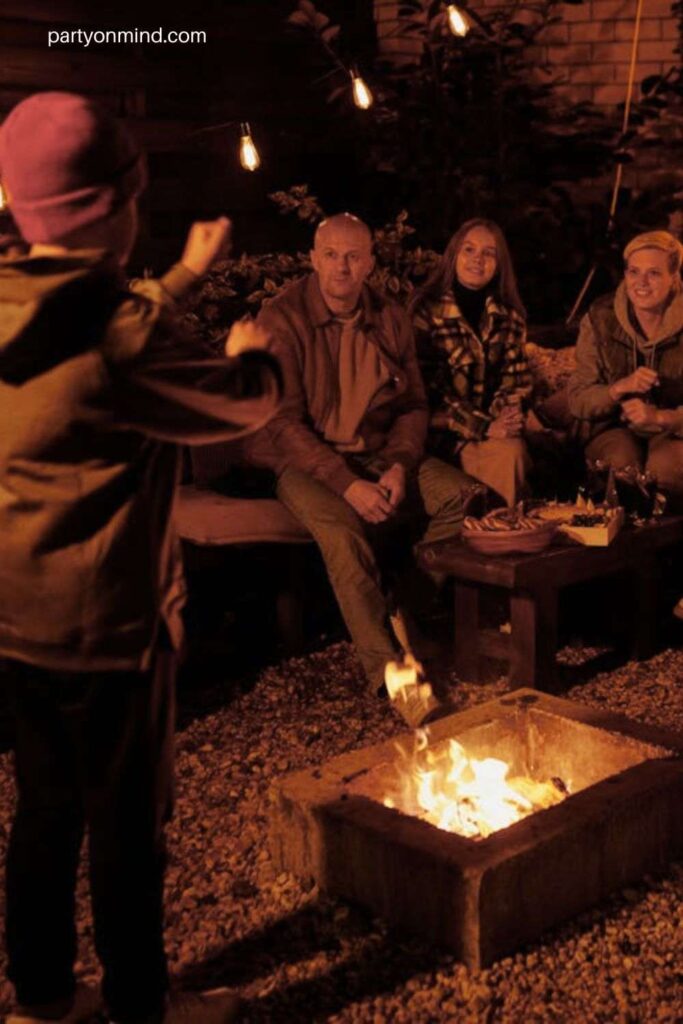Hi, I’m Emma! Icebreaker Games for Adults are essential tools for creating a fun, engaging atmosphere in social settings. These games play a crucial role in breaking down barriers and easing the tension that often accompanies unfamiliar social situations. Whether at a party, team-building event, or gathering, icebreaker games help individuals connect by fostering communication and encouraging laughter. They are designed to create a comfortable environment where everyone feels included, making it easier to interact, form bonds, and enjoy each other’s company.
Icebreaker Games for Adults
Icebreaker Games for Adults are fun activities designed to help people connect and feel more comfortable in social settings. They break down barriers and spark conversations, making any gathering more enjoyable and relaxed.
Human Bingo
Create bingo cards with different traits or experiences (e.g., “Has traveled to Europe,” “Can speak two languages”). Players must find others who match these traits and mark them off. The first person to complete a row or column wins.
- Customize the traits based on the group to make it more engaging.
- Encourage participants to ask open-ended questions to get to know each other.
- Use fun or quirky categories to make the game light-hearted.
- Keep the pace lively to maintain energy and interest.
Two Truths and a Lie
How to play: Each participant shares three statements about themselves—two truths and one lie. Others must guess which one is the lie. This game sparks conversation and helps uncover interesting facts about people.
Tips:
- Keep the truths and lies surprising or funny to make the game more fun.
- Give people a moment to think about their statements to ensure variety.
- Encourage creative or unexpected lies to make guessing harder.
- Remind everyone to keep it light-hearted to avoid uncomfortable situations.
Would You Rather?
How to play: Ask participants a series of fun, thought-provoking questions where they must choose between two options (e.g., “Would you rather be able to fly or be invisible?”). Participants take turns answering.
View this post on Instagram
Tips:
- Tailor questions to the interests of the group for maximum engagement.
- Encourage group discussions after each question to hear different perspectives.
- Keep questions light and funny to avoid awkwardness.
- Offer a mix of silly and serious questions to keep it balanced.
The Hot Seat
How to play: One person sits in the “hot seat,” and others take turns asking them rapid-fire questions for a set amount of time. The person in the hot seat must answer as quickly as possible.
Tips:
- Keep the questions light-hearted to avoid any discomfort.
- Allow the person in the hot seat to pass if they’re uncomfortable.
- Set a timer for each round to keep the game fast-paced.
- Encourage funny or unexpected questions to add humor to the game.
The Charades
How to play: A player acts out a word or phrase without speaking, while others try to guess it. You can use categories like movies, animals, or famous people. The player has a set time to act it out.
- Choose a variety of categories to keep it interesting.
- Use a timer to keep the game moving quickly.
- Encourage exaggerated acting to make it more entertaining.
- Have a designated scorekeeper if you want to make it competitive.
Speed Networking
How to play: Pair participants up and give them 3-5 minutes to introduce themselves and chat. After the time is up, switch partners and repeat. This game allows people to meet multiple new faces in a short time.
Tips:
- Set clear goals for each interaction (e.g., “What do you do for work?”).
- Encourage people to ask open-ended questions to keep conversations flowing.
- Make sure everyone knows to move on after the time limit to keep it moving.
- Ensure everyone has a chance to talk by circulating frequently.
Who Am I?
How to play: Write the names of famous people or characters on sticky notes and place one on each participant’s forehead. They must ask yes/no questions to figure out who they are.
Tips:
- Choose well-known figures that everyone can recognize.
- Limit the number of questions to keep the game moving.
- Encourage funny questions to keep the atmosphere light.
- Rotate the sticky notes to give everyone a chance to guess.
Icebreaker Questions Jar
How to play: Fill a jar with various icebreaker questions (e.g., “What’s your favorite childhood memory?”). Players take turns drawing a question and answering it. This is a great way to get deeper conversations started.
Tips:
- Use a variety of question types (fun, serious, and creative).
- Encourage people to elaborate on their answers to foster meaningful conversations.
- Make sure everyone has a chance to answer.
- Keep the atmosphere light so that no one feels uncomfortable with their answers.
The M&M Game
How to play: Each player grabs a handful of M&Ms or any colored candy. Each color represents a different category of questions (e.g., red = favorite vacation, yellow = embarrassing story). Players answer the question based on the candy they pick.
Tips:
- Personalize the categories to make the questions more relevant to the group.
- Keep the questions light to ensure everyone is comfortable.
- Allow people to pass if they don’t want to answer a specific question.
- Make sure everyone has the same number of candies to keep it fair.
Telephone Game
How to play: Players sit in a circle. One person whispers a sentence to the next player, who whispers it to the next, and so on. The last person says the sentence aloud, and the group compares it to the original.
Tips:
- Keep the sentence short and clear to prevent confusion.
- Start with something fun and silly to make the game more entertaining.
- Encourage laughter when the final sentence is revealed.
- Make sure everyone understands the rules before starting.
The Name Game
How to play: Each player says their name and an adjective that starts with the same letter as their name (e.g., “Jolly John”). The next person must repeat the previous names and add their own. This continues until everyone is introduced.
- Use a fun, memorable adjective to make it easier to recall names.
- Encourage creativity and humor when choosing adjectives.
- Start with a volunteer to get the game going.
- Make sure everyone repeats the names aloud to help with memory.
Pictionary
How to play: Players take turns drawing a word or phrase while their team guesses what it is. Use a timer to keep it competitive. You can use a pre-made list of categories or let players choose their own.
Tips:
- Use simple words or phrases to make guessing easier.
- Encourage fast drawings—stick figures are fine!
- Play in teams to encourage collaboration and camaraderie.
- Keep a whiteboard or large paper handy for easy drawing.
20 Questions
How to play: One person thinks of an object, person, or place. The others have 20 questions to ask (yes/no questions only) to figure out what it is. The goal is to guess before running out of questions.
Tips:
- Choose an interesting object or person to make the game challenging.
- Keep questions broad at first to narrow down possibilities.
- Encourage creative thinking for unique guesses.
- Take turns being the one who thinks of the object to keep it fair.
The Compliment Game
How to play: Players take turns giving a compliment to someone else in the group. The compliment must be genuine and specific, such as “I love how positive you are.”
Tips:
- Encourage people to give meaningful compliments that highlight unique qualities.
- Keep the atmosphere positive and supportive.
- Remind everyone to be sincere with their compliments.
- Set a time limit for each compliment to keep the game moving.
Scavenger Hunt
How to play: Create a list of items or tasks for participants to find or complete within a set time frame. Players can work individually or in teams to complete the list and win a prize.
Tips:
- Customize the list to fit the location or event theme.
- Encourage teamwork by having participants work in pairs or groups.
- Keep the challenges fun and not too difficult.
- Set a time limit to keep the game exciting and fast-paced.
Truth or Dare
How to play: Players take turns choosing either “truth” or “dare.” If they choose truth, they must answer a personal question honestly. If they choose dare, they must complete a challenge given by another player.
Tips:
- Keep the dares light-hearted to avoid uncomfortable situations.
- Encourage creativity for fun and silly dares.
- Set boundaries at the start to ensure everyone is comfortable.
- Rotate who gives the dare to keep it fair and engaging.
Balloon Pop
How to play: Write different challenges or questions on small pieces of paper and place them inside balloons. Players take turns popping a balloon and completing the challenge inside.
- Make the challenges fun and engaging to keep the energy up.
- Use colorful balloons for a festive atmosphere.
- Consider adding a few silly or unexpected tasks for laughs.
- Keep the challenges appropriate for the group’s comfort level.
Word Association
How to play: One player says a word, and the next player has to quickly say the first word that comes to mind. The game continues rapidly, and players must keep up with the pace.
Tips:
- Encourage players to respond quickly without overthinking.
- Start with simple words to get the flow going.
- Use themed words if you want to add a creative twist.
- Keep the pace fast to add excitement and challenge.
Four Corners
How to play: Label each corner of the room with a number or category (e.g., favorite season, favorite food). Players move to a corner that corresponds to their preference when the host calls out a category.
Tips:
- Change categories frequently to keep the game fresh.
- Use categories that everyone can relate to for inclusivity.
- Keep the pace moving so everyone stays engaged.
- Make sure everyone knows which corner corresponds to each option.
Pass the Object
How to play: Players pass around an object while music plays. When the music stops, the person holding the object must answer a question or perform a task.
Tips:
- Use a fun, easily passed object (like a ball or plush toy).
- Have a mix of questions and tasks to keep it interesting.
- Keep the questions light-hearted to avoid discomfort.
- Set a time limit for each round to maintain energy.
Guess Who?
How to play: Write the names of famous people or characters on slips of paper and tape them to each player’s back. Players must ask yes/no questions to figure out who they are.
“Guess Who?” by mrmanc, Flickr is licensed under CC BY 2.0
Tips:
- Use a variety of famous figures to make guessing easier.
- Allow players to ask only yes/no questions to keep it challenging.
- Keep the atmosphere light and fun.
- Ensure everyone has a turn to ask questions.
Tips for Success
Icebreaker Games for Adults are designed to create a fun and welcoming environment, but to make them truly successful, it’s important to keep a few key tips in mind. The goal is for everyone to enjoy the experience, so fostering an inclusive, engaging atmosphere is essential. Here are some helpful tips to make sure your icebreaker games go off without a hitch:
- Keep it light: The main goal is for everyone to have fun. Don’t pressure anyone into participating if they’re not comfortable. The focus should be on enjoyment, not competition or performance.
- Be inclusive: Make sure the games allow everyone to participate, including those who may be shy or quiet. Encourage a comfortable atmosphere where no one feels left out.
- Be mindful of the group dynamic: Choose games that fit the group size and preferences. Large groups may benefit from team-based games, while smaller groups may enjoy more interactive or one-on-one games.
- Adapt as needed: If a game isn’t working, feel free to switch things up. Not every game suits every group, so be flexible and willing to change to keep the energy high.
- Set clear expectations: Let everyone know the rules upfront and ensure that everyone is on the same page. This helps prevent confusion and keeps the game running smoothly.
- Keep the mood light and playful: Encourage humor and light-heartedness throughout the game to help ease any nerves and create a positive atmosphere.
FAQ
What are Icebreaker Games for Adults and Why Are They Important?
Icebreaker games for adults serve as a great way to break the ice in social settings, fostering connections and creating a comfortable atmosphere. These games help overcome initial awkwardness and get everyone involved in a fun, engaging way. Here’s why they matter:
- Promote Communication: They encourage people to talk and share, building better communication.
- Encourage Bonding: Help participants find common ground and make connections.
- Build Confidence: Especially helpful for shy or introverted individuals to feel included.
- Foster Teamwork: They often require collaboration, which strengthens group dynamics.
How Do I Choose the Right Icebreaker Game?
Choosing the right icebreaker game ensures everyone feels comfortable and engaged. Tailoring the game to your group size and preferences will make the experience enjoyable. Here’s how to choose:
- Know Your Group: Consider the size and nature of your group—small groups may enjoy more interactive games, while large groups may need team-based games.
- Consider the Setting: Choose games based on the type of event, whether casual or formal.
- Gauge Comfort Levels: Avoid games that could make people uncomfortable, and opt for light-hearted fun.
- Adapt for Virtual: For virtual events, look for games that can be easily played online or via video call.
What Are Some Tips to Ensure Everyone Participates?
It’s important to create an inclusive atmosphere so that everyone feels encouraged to join in. Here are some tips to boost participation:
- Set a Positive Tone: Start with easy, low-pressure games that invite participation without forcing it.
- Lead by Example: As the host, participate in the game and set an example for others to follow.
- Encourage Group Participation: Choose games where everyone can contribute, even if they don’t want to be the center of attention.
- Be Supportive: If someone is hesitant, offer gentle encouragement without pressuring them.
Can Icebreaker Games for Adults Work for Remote or Virtual Gatherings?
Absolutely! Many Icebreaker Games for Adults can be adapted for virtual meetings or remote events, making them perfect for online gatherings. Here’s how to make virtual icebreakers successful:
- Choose Interactive Games: Games like “Two Truths and a Lie” or “Pictionary” are easy to play virtually.
- Use Technology: Platforms like Zoom or Microsoft Teams can help facilitate these games.
- Set Clear Instructions: Make sure everyone understands how to play before starting.
- Stay Engaged: As a host, keep the energy high and encourage everyone to participate actively.

I’m Emma Rosenthal, an event planner based in New York City with a passion for bringing people together through unforgettable celebrations. I created partyonmind.com to share my best party ideas, wedding inspirations, and fun games for kids, adults, and everyone in between. Whether you’re planning a small gathering or a grand event, I love helping you make every occasion special with creative and engaging activities. Let’s make every party one to remember!
![Fun Party Games Ideas for Kids, Adults [Party On Mind]](https://partyonmind.com/wp-content/uploads/2025/02/on-1-316x90.png)







